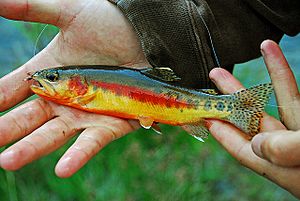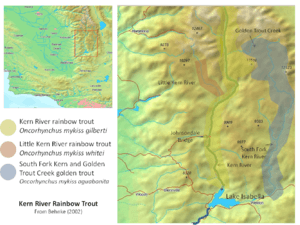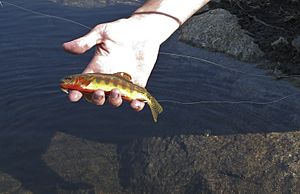Golden trout facts for kids
Quick facts for kids Golden trout |
|
|---|---|
 |
|
| Conservation status | |
| Scientific classification |
|
| Kingdom: | Animalia |
| Phylum: | Chordata |
| Class: | Actinopterygii |
| Order: | Salmoniformes |
| Family: | Salmonidae |
| Genus: | Oncorhynchus |
| Species: | |
| Subspecies: |
O. m. aguabonita
|
| Trinomial name | |
| Oncorhynchus mykiss aguabonita (Jordan, 1892)
|
|
 |
|
| Kern River trout range map | |
The California golden trout, often just called the golden trout, is a special type of trout. Its scientific name is Oncorhynchus aguabonita or Oncorhynchus mykiss aguabonita. This beautiful fish is only found naturally in California. It lives in places like Golden Trout Creek, Volcano Creek, and the South Fork Kern River. The golden trout is so important that it's the official state freshwater fish of California!
This fish is closely related to two other types of rainbow trout. These are the Little Kern golden trout and the Kern River rainbow trout. Together, these three fish are sometimes called the "golden trout complex."


Contents
What is a Golden Trout?
The golden trout is a type of fish that scientists have studied for a long time. It was first thought to be a subspecies of salmon. A subspecies is like a special group within a species. Think of it like different breeds of dogs, which are all dogs but look a bit different.
Today, some scientists believe the golden trout is its own unique species. Others still see it as a subspecies of the rainbow trout. This shows how much there is to learn about these amazing fish!
How Do They Look?
Golden trout are truly stunning! They have shiny golden sides with red stripes along their bodies. They also have about 10 dark, oval spots on each side. These spots are called "parr marks." Their fins have white edges, which makes them look even more striking.
In their natural homes, adult golden trout are usually about 6 to 12 inches (15 to 30 cm) long. A fish over 12 inches is considered quite large! However, some golden trout that have been moved to lakes have grown much bigger. The largest recorded was about 11 pounds (5 kg)!
It's important not to confuse the golden trout with the "golden rainbow trout." The golden rainbow is a different color version of the regular rainbow trout.
Where Do They Live?
Golden trout usually live in high places, from about 6,890 feet (2,100 meters) to 10,000 feet (3,000 meters) above sea level. They are native to the southern Sierra Nevada mountains in California.
Outside of California, you can find golden trout in very high mountain areas. These spots are often hard to reach, sometimes needing special climbing gear. They like water that is about 58 to 62°F (14 to 17°C). They can handle slightly warmer water if it cools down at night. The only other fish naturally found where golden trout live is the Sacramento sucker.
Amazing Catches
People love to fish for golden trout, and some have caught truly impressive ones! The state record for Wyoming was a golden trout that measured 28 inches (71 cm) long. It weighed 11.25 pounds (5.1 kg) and was caught in Cook Lake, Wyoming, in 1948.
Another record was set in 2012 in Golden Lake, Wyoming. This fish was 53 cm (21 inches) long.
Where Are They Found?
The California golden trout is originally from the southern Sierra Nevada mountains. This includes the upper parts of the South Fork of the Kern River and Golden Trout Creek.
However, people have moved these fish to hundreds of other lakes and streams. This was often done for sport fishing. Many of these new populations did not survive. Others mixed with different types of trout, which changed their unique features.
Self-sustaining populations of golden trout now live in California, Idaho, Montana, Utah, Washington, Colorado, and Wyoming. There's also a population in the Rocky Mountains of Alberta, Canada. In Alberta, they move fish between lakes to keep the populations healthy.
Chuck Yeager's Role
A famous pilot named Chuck Yeager loved golden trout. He introduced his commanding officer, General Irving "Twig" Branch, to these fish. General Branch then asked Yeager to help bring golden trout to the mountain streams of New Mexico. However, these populations in New Mexico did not last.
In his book Press On, Chuck Yeager wrote about his yearly fishing trips for golden trout. He said they were one of the best fish to catch and eat.
History of the Golden Trout
The California golden trout was first described in 1892 by David Starr Jordan. He was the first president of Stanford University. He named the fish Salmo mykiss agua-bonita after the Agua Bonita Waterfall. This is where the first fish were found.
Later, in 1904, a writer named Stewart Edward White told President Theodore Roosevelt that golden trout were being overfished. He worried they might disappear. President Roosevelt shared this concern. He sent a biologist named Barton Warren Evermann to study the fish.
In 1906, Evermann wrote a book about the golden trout. He described four different types of these native fish. Later genetic studies helped us understand that there are three main groups of trout native to the Kern River area:
- California golden trout (O. m. aguabonita)
- Little Kern River golden trout (O. m. whitei)
- Kern River rainbow trout (O. m. gilberti)
Protecting Golden Trout
For many years, golden trout have faced big challenges. Too much fishing, poor management, and competition from fish that don't belong in their habitat have put them in danger. They are now close to being called "threatened."
Why Are They in Danger?
- Introduced fish: Other fish like brook trout eat the same food as golden trout. Brown trout even eat golden trout!
- Hybridization: Introduced rainbow trout can breed with golden trout. This creates "hybrid" fish that are not pure golden trout. This damages the natural golden trout gene pool.
- Habitat loss: Their homes have been damaged by too much grazing from cattle and sheep.
- Other threats: Things like floods, droughts, and fires can also harm their habitats.
Because of these problems, the number of golden trout has been going down for many years.
What's Being Done?
People are working hard to protect these special fish.
- In 1978, the Golden Trout Wilderness was created. This protected the important areas where the Kern River and South Fork Kern River begin.
- In 2004, the California Department of Fish and Game made an agreement with other groups. They decided to work together to fix the damaged habitats in the back-country.
Conservation Status
Different groups have looked at how endangered the golden trout are:
- The California golden trout (Oncorhynchus mykiss aguabonita) is considered "Critically Imperiled." This means it's in extreme danger. The biggest problem is that they are mixing with stocked rainbow trout. Very few pure golden trout populations are left.
- The Kern River rainbow trout (Oncorhynchus mykiss gilberti) is also "Critically Imperiled." They face similar threats like mixing with other trout and losing their habitat.
- The Little Kern golden trout (Oncorhynchus mykiss whitei) is considered "Imperiled." This means they are also in danger. They are threatened by mixing with introduced rainbow trout and other fish.
Since 2008, the American Fisheries Society has listed all three of these trout as "Threatened." This shows how important it is to protect them.
See also
 In Spanish: Trucha dorada para niños
In Spanish: Trucha dorada para niños


